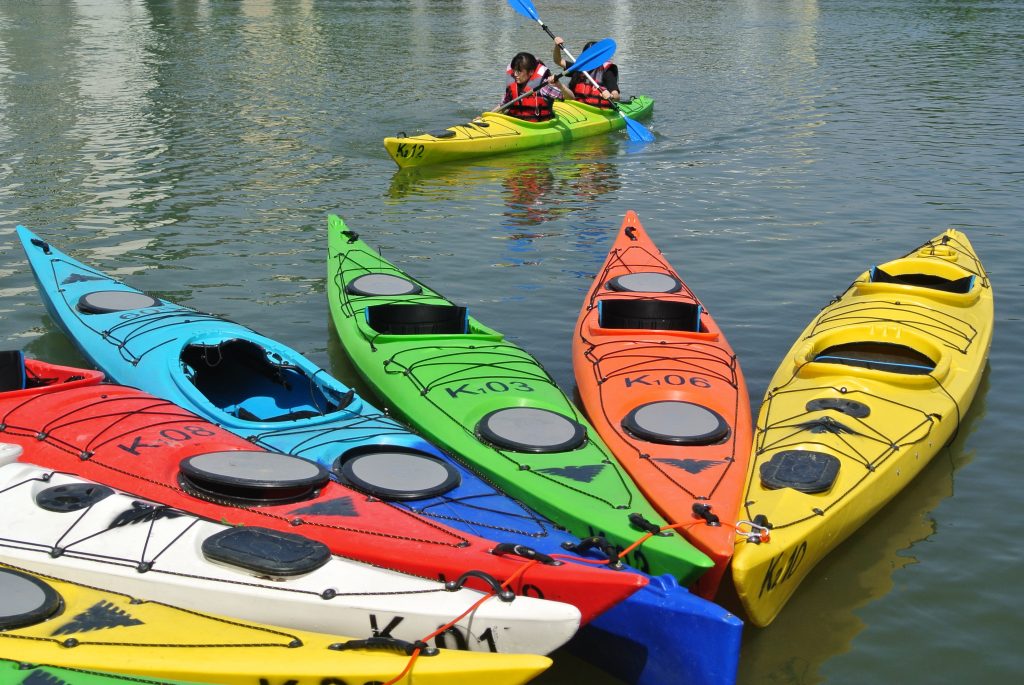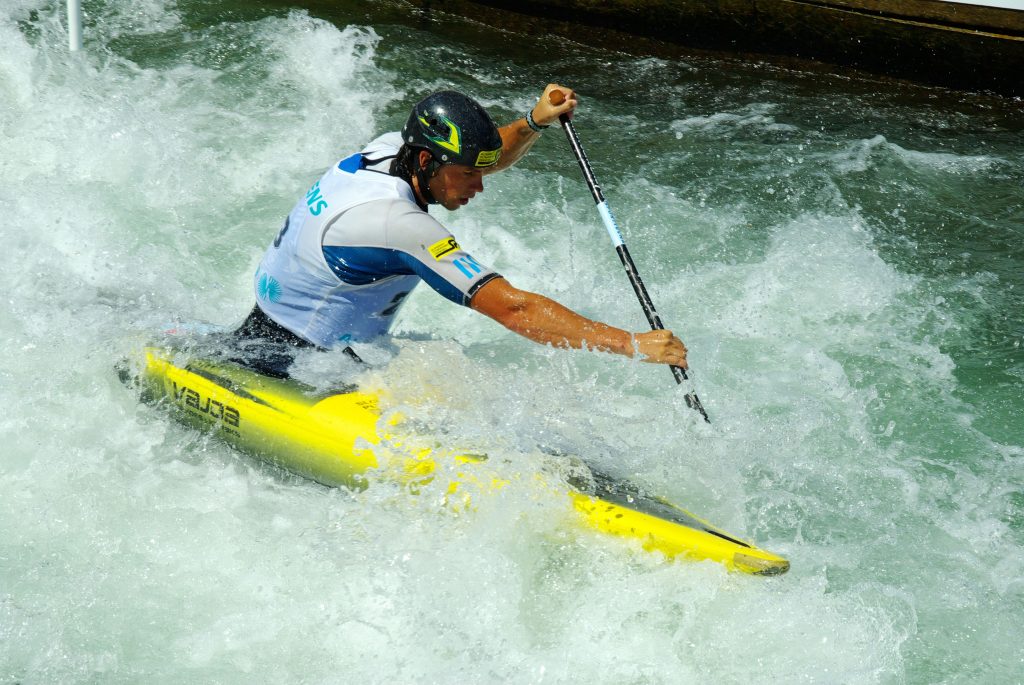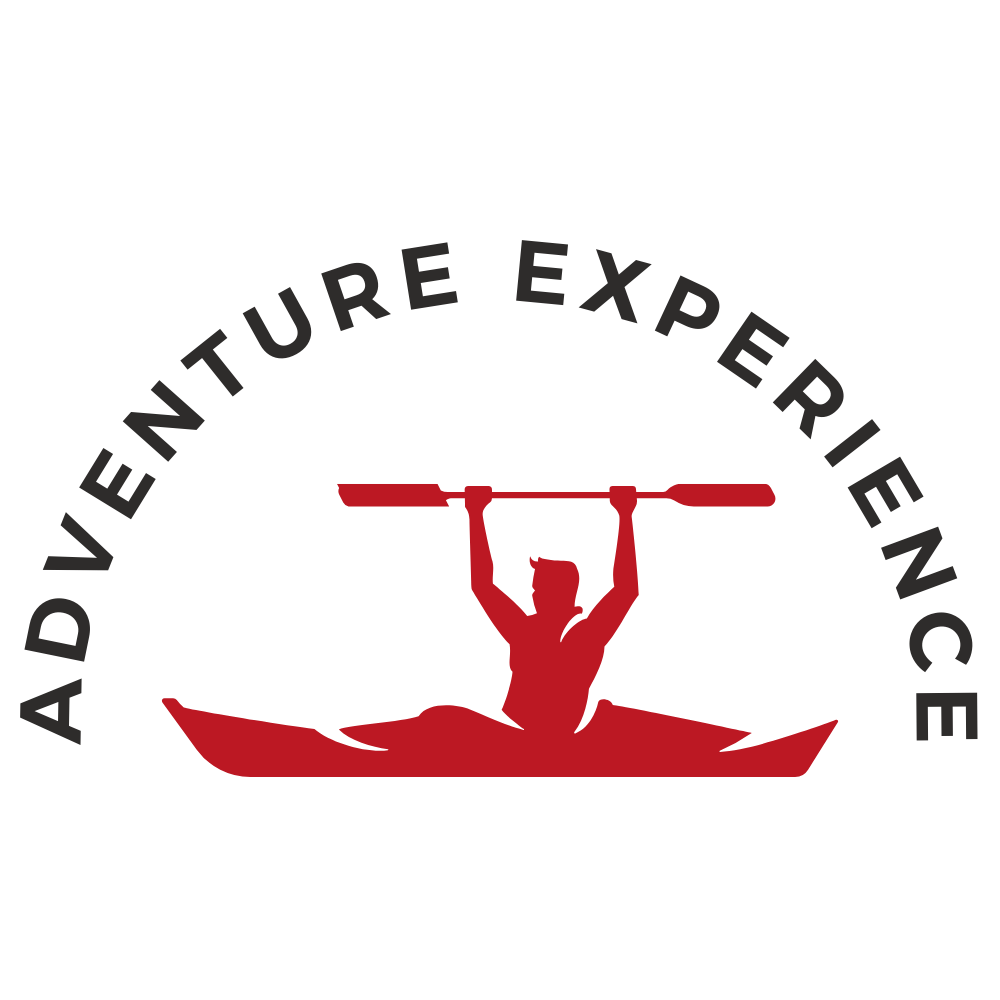There are two main categories of kayaks; Flat water and Whitewater.
There are basically 5 types of flat water kayaks and 4 types of whitewater kayaks. Written and published by Mike McEntire, AKA’S founding President
Flat Water Kayaks:
There are 5 types of flat water kayaks; sit-on-top, recreational, touring, inflatable and pedaling kayaks. Each has their advantages and disadvantages.
Sit-on-top kayaks do not have a closed cockpit, so they are easy to get into and out of. They are usually wider than most, so they have good primary stability. They are nice for fishing because all of your gear is easily accessible. They have a huge disadvantage of sometimes being a wet ride, if you are careful you can stay dry, but most of the time you will get a little wet from splashes, which is nice in the summer, not so nice in the winter. With some practice you can enter some of these kayaks while floating in deep water, which is nice if you go for a swim, intentionally or unintentionally.



Recreational kayaks have a closed cockpit, but it usually a fairly large opening, Large enough to put a small child in there with you. They are shorter than touring kayaks, usually 10 feet or less. They are nice because in the summer you can leave the cockpit open for a nice cool ride, but in the winter you can use a skirt and have a dry warm trip. They are significantly cheaper than touring kayaks and since they are shorter they are easier to store and transport. They are shorter, so they are not as fast as touring kayaks because they don’t track as well. Tracking is the ability of a kayak to go straight instead of turning when you don’t want it to. A kayak that does not track well will turn to the right when you paddle on the left and vice versa. Generally the longer the kayak the better it tracks. Some recreational kayaks get better tracking by the use of a skeg or rudder.
Touring kayaks are usually 12 feet or longer, they generally have smaller cockpits. They are also narrower. The smaller cockpit also has thigh braces in it so that if the kayak rolls over the paddler uses his thighs and hips to roll himself back upright. These kayaks are expensive, usually about $800 used and $1200 or more new. They are very fast because they are so narrow and long. Most touring kayaks use a rudder to help them turn. They are difficult to store and transport because of their length. These kayaks are more often used on long trips across large bodies of water and are not as useful for the family on an afternoon trip to the lake where a recreational or sit-on-top would be better.
Pedaling kayaks are great for people who have back or shoulder problems because the only time you need to use your arms is when pulling into shore. They are also wonderful because you can go much farther distances because you are now using muscles with more “slow-twitch” fibers that are better for longer duration than the “fast-twitch” fibers that are in your arms. The greatest disadvantage to these kayaks is the price. There are 2 pedaling kayaks that I know, and both are great. One type uses a propeller and you pedal it like a bicycle. The other type uses flippers like a fish. I personally went for the “Hobie Mirage” series which has the flippers and I love it. If I get a chance I’ll try out the kind with a propeller and later tell you how it is.
Note: If buying a used flat water kayak, make sure you don’t accidentally get an old school whitewater kayak. You will recognize them because they are usually about 10-12 feet long, have small cockpit openings, and when they are sitting on the ground the ends turn up instead of lying flat on the ground.
Inflatable flat water kayaks are not going to get and favorable opinion from me on these. I consider them useless (TOYS). They track horribly, are not very comfortable and you have to worry about popping them. In my opinion if you feel you don’t have to the space to for a hard shell kayak, then get rid of your couch and put your kayak in the living room. It makes a great conversation piece, is a nice chair to read a book in and can be used as a Japanese style table on the floor. If your wife objects that it doesn’t match the décor, tell her you’re going for a “kayak” theme which is all the rage in Europe.
Whitewater Kayaks
Playboats, River Runners, Creekboats, Old School, and Inflatable (Duckies)
Playboats are where I see a lot of new kayakers go wrong. They see one of these kayaks for sale and think they can use it to run a river. These kayaks are mostly for going to a spot on and staying and playing on the standing waves and holes. Do not buy one of these boats if you plan on starting from once spot on the river and traveling down the river to another spot. These kayaks are uncomfortable because playboaters need to be “one” with their kayak. These kayaks are very short, usually about 6 feet. They are very fun if you have an area to go that has waves and holes. They are nice to do tricks in and have your girlfriend sit on the bank and watch what hunk you are. They are also a very enjoyable alternative to going to the gym, a couple hours at your favorite play spot will get rid of those love handles in no time.
River Runners are usually about 7-8 feet long. This is a nice length to give a little bit of tracking for the long flat sections of the river that your inevitably have to through, but short enough to manage the tight turns that the river makes. These kayaks are fairly comfortable and have plenty of room to store gear for a couple days.
Creekboats (Creekers) are usually 8 feet or longer have a lot of volume to enable you to resurface. They are pretty comfortable, and usually a little more heavily built to withstand the drops. Watch out if you are a beginner. Some creekboats have a displacement hull. A displacement hull is nice for drops but when using one to run rivers they can be a bit tricky in holes and crossing eddy lines. If you are just beginning then I recommend a planning hull. Planning hulls are better for a wider variety of water. Displacement hulls are best for creeks and big drops. Of course this is just my opinion, and I’m sure you’ll find someone who thinks otherwise.
Old School Kayaks (Long Boats) are quite common on used sites. These are kayaks made in the late 80’s and early 90’s. They definitely have some advantages, and if you know what you want they can be very useful. They are quite long compared to modern boats. They are usually 10-12 feet. This extra length is nice if you run rivers that have a lot of flat water between rapids. Their length can be a problem if you are running some tight turns. The other disadvantage is they usually have a very small cockpit which is not as comfortable as modern boats. The other reason for large cockpits is safety. That large cockpit on newer boats is nice and fast to get out of when you’re in a pinch. These boats are very cheap, $200 can often get you a kayak, skirt and paddle.
Inflatable Whitewater Kayaks (Duckies) are just the opposite of inflatable flat water kayaks which are worthless. Inflatable whitewater kayaks are wonderful and a great way to start out your whitewater career. They are very stable because of how wide they are. They can haul a lot of gear. They are more comfortable than hard-shell whitewater kayaks because you can periodically shift your position. These kayaks are so easy to use that many companies will rent you one after a 2 hour course and let you run class II and III rivers. I have personally owned 2 and used them on up to class IV and it was great. Their only downside is they don’t perform as well in rivers with a lot of tight turns. If it wasn’t for that I would love to use one more often.
There are hybrids of all these kayaks. For example the hybrid between a playboat and a river runner is often called “Free Running Kayak”. They have enough length and comfort to get you down the river, but then if you find a nice play spot you can stop, have some fun, then continue on your way.
